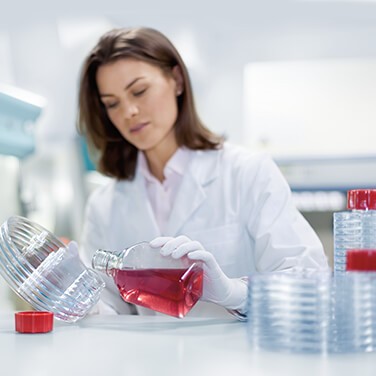Save Incubator Space with Round Multilayer Devices
Mass cell culture is used to produce large quantities of cells for industrial or clinical applications.
A variety of systems and products are available to support mass cell culture. Your choice will depend upon multiple factors, including the cost and efficiency of your scale-up processes. When evaluating multilayer devices like the Greiner Bio-One CELLdisc, consider not only the growth area and number of cells per device but also the most effective use of available incubator space.
The ergonomic round design of the innovative CELLdisc is different from the mostly rectangular devices currently sold. The dimensions and shape of the rectangular devices imply optimal usage of the cubic space of an incubator. However, the size of such devices does not directly correlate with the dimensions of standard incubators, which can leave a significant amount of space unused. Furthermore, rectangular devices should not be positioned too closely to each other to ensure optimal thermal distribution.
Because of their round design, CELLdisc devices do not require additional space for thermal equilibrium, even when they are in close proximity. This fact and the 40 percent higher surface/volume ratio than standard competitive systems make the use of incubator space much better for CELLdisc than for rectangular devices (see Table 1).
| CELLdisc | Product A | Product B (high-density) |
|---|---|---|---|
Shape | Round | Rectangular | Rectangular |
Layers | 16 | 10 | 10 |
Dimensions (including screw cap) | Dia. x H: 20 x 22cm | L x W x H: 33 x 20 x 20.5cm | L x W x H: 33 x 23 x 21cm |
Growth Surface/Device | 4,000cm3 | 6,360cm3 | 8,216cm3 |
Max. Devices/Shelf | 6 | 2 | 2 |
Max. Devices/Incubator | 12 | 4 | 4 |
Total Growth Surface/Incubator | 48,000cm3 | 25,440cm3 | 32,684cm3 |
Utilization (vs. CELLdisc) | 100% | 53% | 68.47% |
Table 1: Utilization of incubator space — examples of other comparable multilayer devices
Greiner Bio-One Cell Culture Plastics can be tissue-culture treated to make the surface hydrophilic, which is ideal for cellular adhesion.
The Advanced TC polymer modification changes the plastic surface in a way that increases primary and long-term cell adhesion and positively influences cell-dependent features and function. Enhanced cell attachment and higher proliferation rates facilitate rapid cell expansion even under restricted growth conditions. The cultivation of sensitive cells is improved, and transfected cells exhibit higher transgene activity when grown on Advanced TC surfaces.
The plastic modifications are readily reproducible, which helps maximize product quality. In addition, room-temperature transport and storage simplify handling.
Key Features
- Minimum space required for device handling
- 40 percent higher surface/volume ratio than conventional multilayer systems
- Surface treatment for optimal cell attachment
- Optimal ventilation through central gas support channel
- Gas inlet and outlet equipped with filters
- Easy accessibility due to wide opening port
- Predictable scale up within one format (250cm² to 10,000cm²)
- Suitable for basic research as well as industrial applications

Content provided by:
Read More from Lab Reporter Issue 2, 2019
- Adaptive Fabric Responds to Changes in Body Temperature
- Brain Metabolism Study Reveals Age Differences Between Sexes
- Chemical Accelerators: The Glove-Related Allergen of the 21st Century
- Ductless Fume Hood Safety
- How to Choose the Right Desiccator
- How to Guard Against Cleanroom Contamination
- Microplastics: Investigating Risk and Understanding Evidence
- Protecting n-Butyllithium from Air and Moisture
- Reduce Strain with Ergonomically Certified Gloves
- Safety Compliance: A Team Effort at Texas A&M
- Save Incubator Space with Round Multilayer Devices
- Second HIV Patient in Remission After Stem Cell Transplant
- Solvent Exposure Can Lead to Hearing Loss
- TCI: Innovating to Improve Lab Safety



